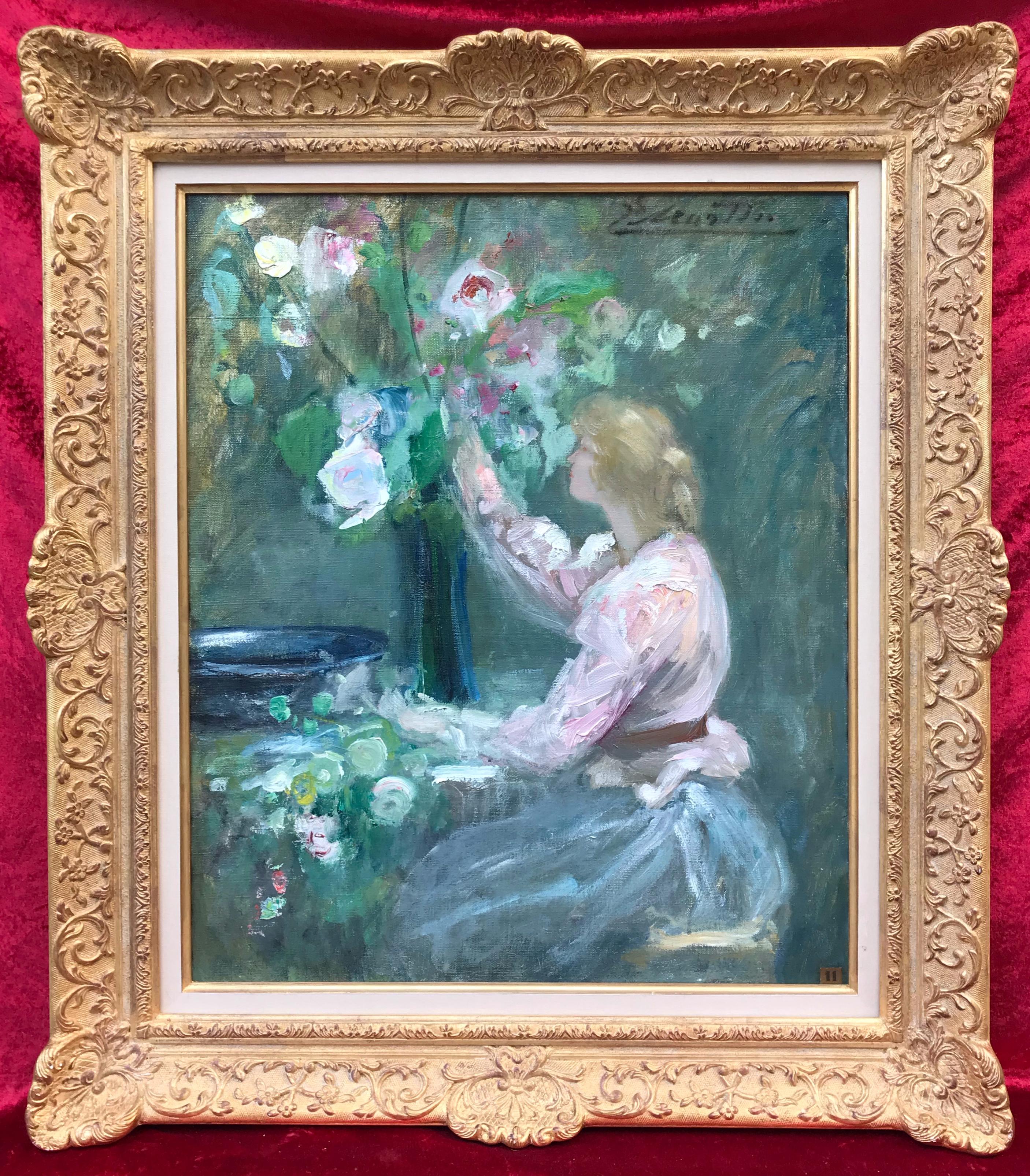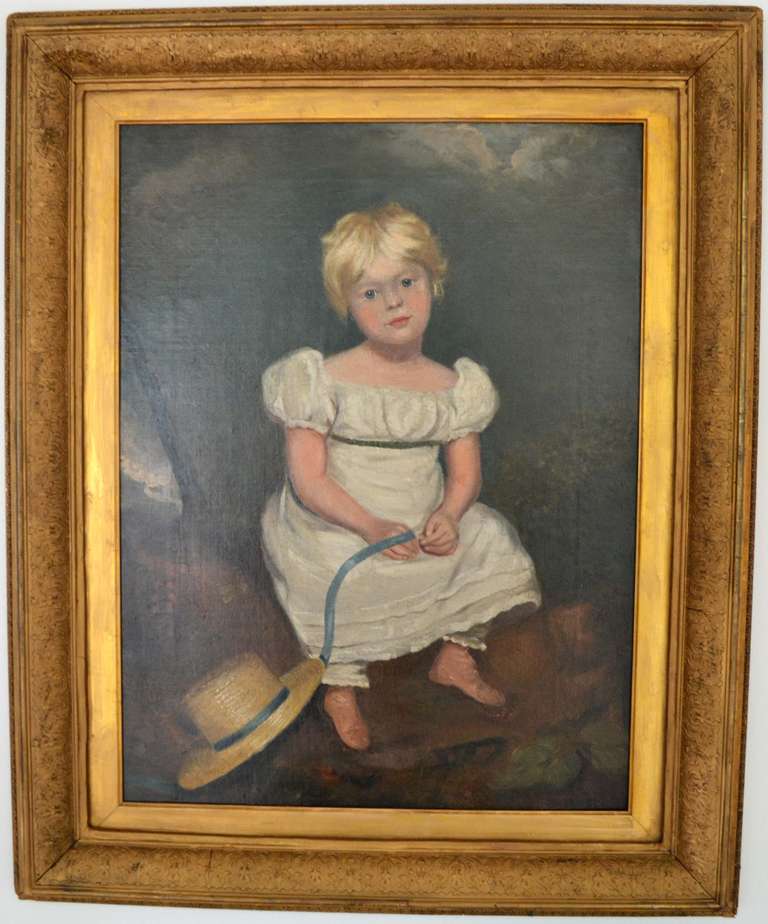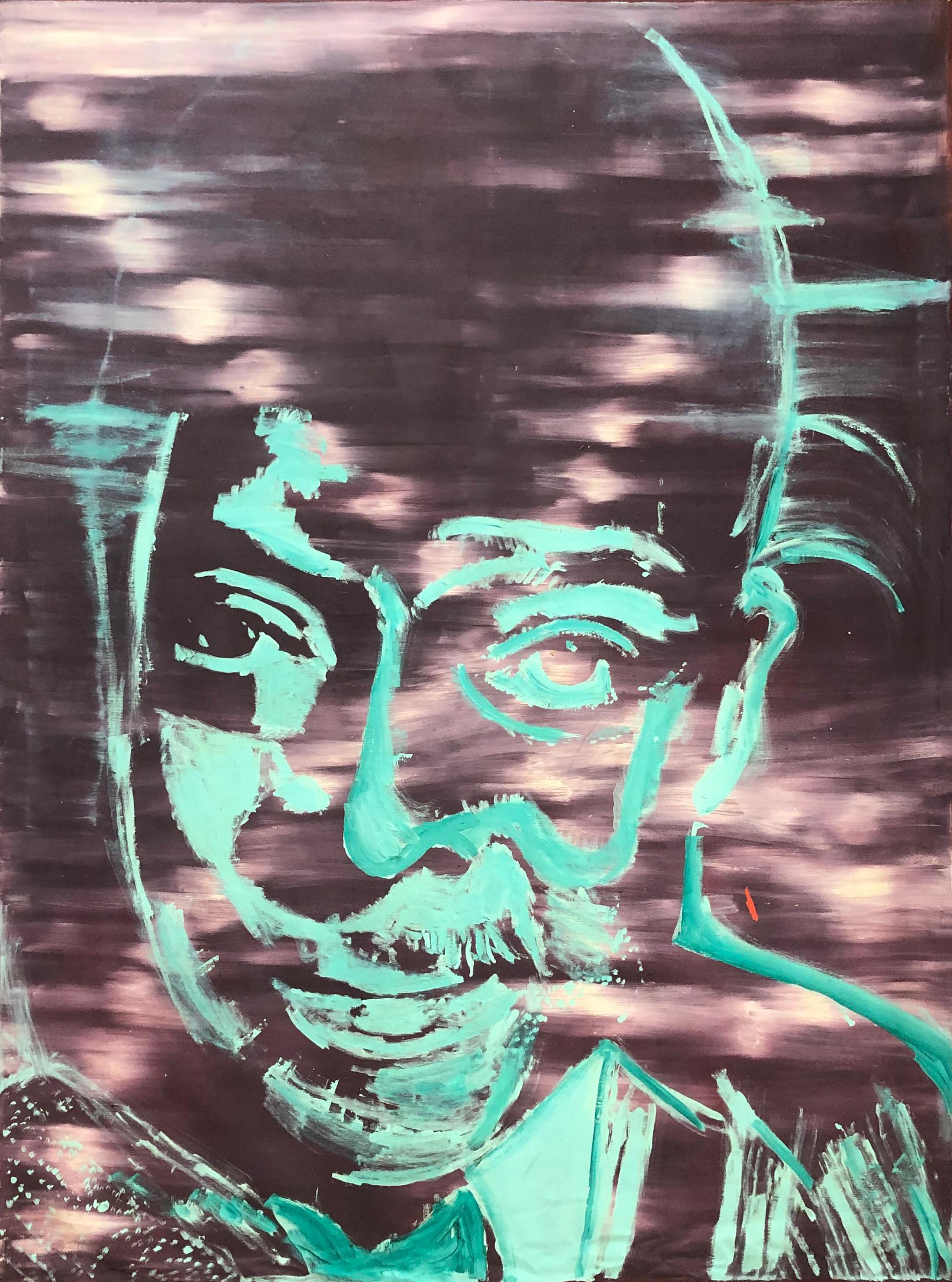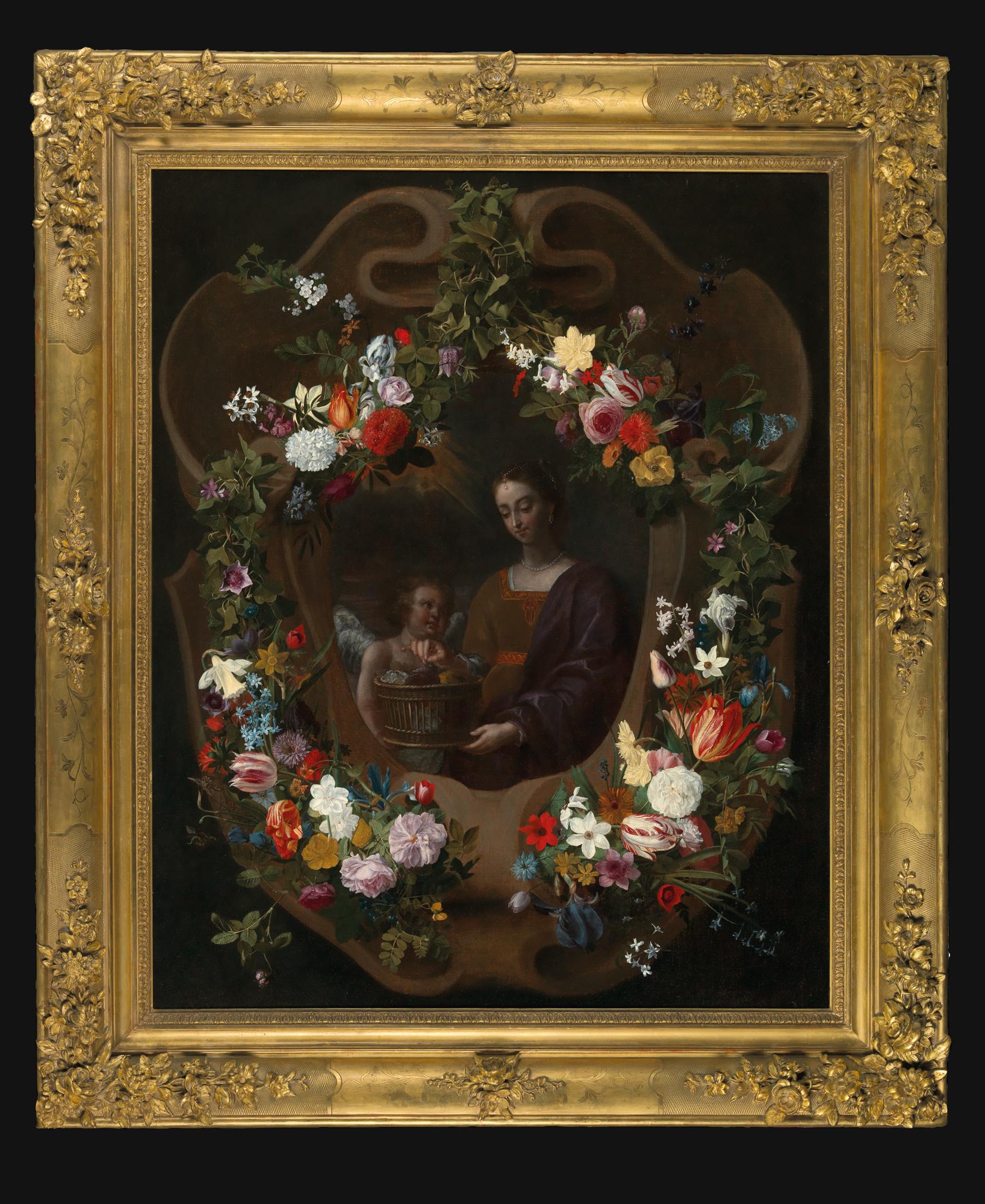Items Similar to Woman with a Bouquet of Flowers, 1970s Framed Female Portrait Oil Painting
Video Loading
Want more images or videos?
Request additional images or videos from the seller
1 of 16
Marcel RonayWoman with a Bouquet of Flowers, 1970s Framed Female Portrait Oil Painting 1978
1978
About the Item
"Jennifer", portrait of a woman with long brown hair and a blue dress with bouquet of flowers in a green vase, vintage 1970s original painting by Marcel Ronay (1910-1998). Female figure with brown hair in a blue dress holding flowers by a bouquet of blue, red, white and green with a golden yellow background. Signed and dated 1978 by the artist, lower right. Presented in a custom carved wood frame with gold accents, outer dimensions measure 37 ½ x 31 ¼ x 2 ½ inches. Image size is 30 x 24 ¼ inches.
Expedited and international shipping is available - please contact us for a quote.
About the Artist:
Marcel Ronay (1910-1998) was born in Budapest, Hungary. During his childhood he lived in Berlin, Germany and Vienna, Austria where he studied under Eugene Steinhof at the Kuntsgewerbeschule. He then traveled and showed his work in Italy before settling in England where he opened Ronay Studios in 1936. In addition to his paintings and sculpture, Ronay also worked in the family business designing and painting porcelain jewelry. Exhibited: Royal Academy, International Exhibition of of Contemporary Sculpture (1952), Royal Institute of Oil Painters, Ben Uri Art Gallery, London (Solo, 1986), John Denham Gallery, Hampstead (Solo, 1995), Den Haag and Brussells (traveling exhibition, 1995)
- Creator:Marcel Ronay (1910 - 1998, Hungarian)
- Creation Year:1978
- Dimensions:Height: 37.5 in (95.25 cm)Width: 31.25 in (79.38 cm)Depth: 2.5 in (6.35 cm)
- Medium:
- Movement & Style:
- Period:
- Condition:Painting is clean and in very good to excellent condition - please contact us for a detailed condition report.
- Gallery Location:Denver, CO
- Reference Number:
About the Seller
5.0
Platinum Seller
These expertly vetted sellers are 1stDibs' most experienced sellers and are rated highest by our customers.
Established in 1979
1stDibs seller since 2013
265 sales on 1stDibs
Typical response time: 3 hours
- ShippingRetrieving quote...Ships From: Denver, CO
- Return PolicyA return for this item may be initiated within 7 days of delivery.
More From This SellerView All
- 1940 Modernist Still Life with Flowers, Framed Floral Oil Painting, Red YellowBy John Edward ThompsonLocated in Denver, COAn original modernist still life oil painting by John E. Thompson (1882-1945), table is draped in red cloth and flowers in vase are red, yellow, blue/purple and white with green stem...Category
1940s American Modern Interior Paintings
MaterialsOil, Canvas
- Portrait of Artist's Wife with Fruit, 1945 American Modern Oil PaintingBy Hayes LyonLocated in Denver, COUntitled (Portrait of Bessy Lyon, Artist Wife) is an oil on canvas painting by Hayes Lyon (1901-1987) from 1945. Presented in a wood frame, outer dimensions measure 35 ¼ x 29 ¼ x 1 ¾ inches. Image size is 30 x 24 inches. About the Artist: A native of Athol, Kansas, Lyon is primarily associated with Colorado. After several summer vacations at the Boulder Chautauqua and at Manitou near Colorado Springs, his family relocated in 1920 to Boulder where his father had a lumber business. Nine years later they settled in Denver where his father owned the Acme Lumber Company. To comply with his desire for his son’s financial self-reliance, Lyon graduated from the University of Colorado at Boulder in 1931 with a B.A. degree in economics. But shortly thereafter he returned to his first love – art – that ultimately became his career. His interest in the arts was nurtured by his mother, herself a talented amateur artist, and by two of his aunts who served as role models. Beginning in 1932, he pursued a five-year course of study at the Chappell School of Art in Denver which by then had become part of the University of Denver. During his time at the school he studied with John E. Thompson and Santa Fe artist, Józef Bakoś. He also met two other Santa Fe-based artists, Willard Nash and B.J.O. Nordfeldt, when they exhibited at Chappell House, then the home of the Denver Art Museum. Lyon likewise attended the Cooke-Daniels Lecture Series there on the arts in the 1930s. Following graduation with a B.F.A. degree from the University of Denver in 1937, he studied privately for about a year with Andrew Dasburg in Taos, New Mexico, that redirected his attention to the rugged Rocky Mountain landscape, which he saw with directness and painted with an economy of means. His canvas, Winter Vista, done following his study with Dasburg, received the Edward J. Yetter Memorial Prize at the 45th Annual Exhibition of the Denver Art Museum in 1939. The painting was reproduced in the September 1939 issue of the Magazine of Art (Washington, DC). That same year his painting, Mount Evans, was included as one of Colorado’s entries in the American Art Today Pavilion at the 1939 World’s Fair in New York. The money he received from the Yetter Prize financed his trip to Mexico City and Guadalajara in 1939 to see firsthand the frescoes of José Clemente Orozco and Diego Rivera and the easel paintings of David Alfaro Siqueiros. Their work was admired by many Americans who participated in the WPA-era mural projects in the United States in the 1930s and early 1940s. The economic fallout from the Great Depression affecting many American artists at the time likewise resulted in Lyon’s participation in the Colorado Art Project, part of the WPA’s national program. Under its auspices he produced three murals in 1940 about the pioneer era of Fort Lupton, Colorado, which were installed in the auditorium of the local high school. Covering 367 square feet of wall space, one of the murals – Behold the West (the largest one) – incorporates the old fort for which the town is named. Before Lyon painted the murals, the students at Fort Lupton High School researched the history of their community and contributed to their cost, facilitating the murals’ allocation to their school under the Colorado Art Project. In the early 1940s Lyon shifted his focus to two new subjects – bathers, and canyons with conifers – reflecting his ongoing search for personal artistic growth. However, his reliance on structure to create form in his paintings and works on paper alienated some of his longtime followers. Nonetheless, his painting Conifers and Canyons won recognition at the 47th Annual Exhibition at the Denver Art Museum. The watercolor version of the piece was among three hundred works in that medium selected by John Marin, Charles Burchfield and Eliot O’Hara from a national competition held by the Section of Fine Arts (Federal Works Agency) and shown at the National Gallery of Art in Washington, DC, in 1941. Later that year Lyon spent time in California where he saw Orozco’s Prometheus, influencing him to increase his range of originality and expression. In 1942 Lyon enlisted in the U.S. Army, spending almost three years in the Mediterranean Theater – Africa and Italy – preparing camouflage operations and scale models of proposed landing sites. He used his free time in Italy to expand his artistic vocabulary by seeing cultural masterpieces in Rome, Florence, Siena and Milan, and through his extensive contact with Giorgio de Chirico, founder of the scuola metafisica art movement, and Gino Severini, a leading member of the Futurist movement. Because of Lyon’s low army rank and pay, de Chirico did a small watercolor for him signing it, "For Mr. Lyon; G de Chirico, 1944." Lyon often visited de Chirico and his wife, Isa, at their apartment near the Spanish Steps in Rome. Following his Army discharge in 1945 fellow Kansas native, Ward Lockwood, invited him to join the Art Department at the University of Texas at Austin where he taught painting from 1946 to 1951. During this period some of Lyon’s work employed the palette of the School of Paris which he had seen while stationed in Europe, while other paintings had a certain flatness found in some of Lockwood’s work from the 1930s. From 1951 to 1953 he was affiliated with the Lower Colorado River Authority in Austin as an illustrator and editor of the employee magazine. In 1953, following time spent in Mexico, he returned to Denver, working as an illustrator at Lowry Air Force Base until retirement in 1961. During that time he did little of his own art because he also was designing and building a home in Arvada, Colorado, and re-establishing himself in the Denver art community after a decade-long absence. His painting, Autumn Aspens (1953-present location unknown) illustrates his experimentation with abstraction. In the early 1960s he began painting from memory that continued until the steadily degenerative effects of Alzheimer’s disease took their toll a decade later. He depicted scenes from his wartime European sojourn and from his early adulthood. The latter include Souvenir of Boulder (1962), a nostalgic return to his boyhood home in Boulder; and Holly Mayer and Friends, a painting of Glenn Miller and his musicians, inspired by Lyon’s first encounter with jazz in Boulder in the 1920s. His lifelong passion for vintage cars and automobile racing...Category
1940s American Modern Figurative Paintings
MaterialsOil, Canvas
- 1940s Oil Painting Portrait of Two Figures, American Modernist FigurativeBy Angelo Di BenedettoLocated in Denver, COOil on canvas signed by artist Angelo Di Benedetto (1913-1992) featuring two young figures reading a book together while sitting from 1947. Painted in shades of green, orange, red, gray, and green. Image measures 28 x 38 inches, framed dimensions are 33 ¾ x 39 ¾ inches. Painting is in good condition - please contact us for a detailed condition report. About the Artist: Born New Jersey 1913 Died Central City, CO 1992 The son of Italian immigrants from the Salerno province in southern Italy, as a teenager Di Benedetto worked to study at the Cooper Union Art School in New York City (1930-34) from which he graduated with a certificate in freehand drawing. He won a scholarship to the Boston Museum Art School where he studied for three years, beginning in 1934. In 1937, he entered his first juried exhibition at the Montclair Museum in New Jersey, winning first prize and first honorable mention. In December 1938, the Royal Netherlands Steamship Line sent him on a two-month ethnological study trip to Haiti, his first exposure to a different environment outside the United States. In 1940, his Haitian paintings were exhibited at the Montross Gallery in New York – his first solo show. Before World War II, Di Benedetto traveled extensively around the United States doing regional paintings. During the war in 1941, Di Benedetto volunteered for a secret mission based in Eritrea, Africa before the Allied invasion. Following Africa, he served as an orientation officer and aerial photographic officer in the District of Columbia. In 1945 he was assigned to a mapping unit at Buckley Airfield in Denver where he served until his discharge in 1946. Like many other servicemen stationed at the time in Colorado, Di Benedetto chose to remain in Colorado, impressed by the state’s physical grandeur and healthful climate. He settled in the old mining town of Central City in 1947. In 1949 Di Benedetto and his wife, ceramist Lee Porzio, opened the Benpro Art School in his studio where he conducted summer art classes. In 1950, Di Benedetto teamed up with Frank Vavra...Category
1940s American Modern Portrait Paintings
MaterialsCanvas, Oil
- Two Ladies Trying to Out-Mystify Each Other, Semi Abstract Figural Oil PaintingBy Edward MarecakLocated in Denver, CO'Two Ladies Trying to Out-Mystify Each Other', Original 1969 semi-abstract cubist style oil painting portraying two female figures with still life. Figural abstraction, oil paint on ...Category
1960s American Modern Abstract Paintings
MaterialsCanvas, Oil
- The Dance of Salome, Abstracted Figural Framed Triptych, 1960s Oil PaintingsBy Edward MarecakLocated in Denver, COThe Dance of Salome or the Dance of the Seven Veils is a Triptych painted in 3 panels in oil on board. Each panel depicts a semi-abstract, cubist style individual figure: Herod, Herodias and Salome. Painted in bright colors of yellow, orange, red, green, fuchsia, purple, pink, white, blue, black and brown. Presented in vintage frames, framed dimensions of each panel measure 29 x 17 x 1 ½ inches, Image size is 23 ½ x 12 ¼ inches, each. Overall dimensions of the triptych measure 29 x 53 ½ x 1 ½ inches as displayed with 1 inch spacing between each panel. Based on the Dance of Seven Veils in which Princess Salome danced...Category
1960s American Modern Portrait Paintings
MaterialsCanvas, Oil
- Still Life with Pink Roses, Framed Interior Oil Painting with Pink and OrangeBy David SpivakLocated in Denver, COUntitled (Still Life with Pink Roses) is an oil on canvas painting by David Spivak (1893-1932) . Presented in a custom gold frame, outer dimensions measure 19 ⅞ x 24 x 1 ¼ inches. Image size is 12 x 16 inches. Painting is clean and in very good vintage condition - please contact us for a complete condition report. Provenance: Private Collection, Denver, Colorado Expedited and international shipping is available - please contact us for a quote. About the Artist: Born in Philadelphia in 1893, David and his family moved to Denver in 1895 due to his mother’s ill health. He attended elementary and high school in Denver, and was briefly enrolled at the University of Denver, where his mother taught Russian. He was drawn to art at a young age, however the University of Denver did not offer a degree program in fine art, and art education in the Denver area was lacking. Spivak’s father, Dr. Charles Spivak, prominent Denver physician and founder of the Jewish Consumptives Relief Society, was concerned about his son’s career choice, hoping David would instead follow in his footsteps. David’s mother, however, recognized her son’s artistic talent and felt it needed nurturing. In 1912, Spivak moved to Chicago to attend the Chicago Art Institute where he worked under John Morton and Wellington Reynolds (1865 – 1949). After a two-year stint in Chicago, Spivak spent 3 years in New York attending the Arts Students League where he studied under Robert Henri, a prominent Ashcan School artist. Between 1914 and 1917, Spivak mostly painted portraiture, and Henri’s artistic influence can be seen in Spivak’s work during this period. Spivak was drafted into the Army in 1918 because of World War I. He spent a year stationed at Kelly Field in San Antonio, Texas. In 1919, he moved back to Denver in and began working as an artist. His dedication to art extended beyond art making into education. He taught at various high schools throughout Denver, as well as the Denver Academy of Applied Arts, the Denver Art Institute, and the Chappell School of Art. Spivak was also a central figure in the art community, helping to develop the Denver Art Museum, as a founding member, along with Dean Babcock and Albert Bancroft, of the Denver Artists’ Guild in 1928 (where he served as president at the time of his death), and as the head of fine art exhibits at the Colorado State Fair. He believed that bringing art into the lives of all people, regardless of status or class, was paramount. In his short life, Spivak was quite prolific, producing over 300 paintings between 1914 and 1932. He excelled in landscape painting and portraiture, and his style was rooted in impressionism. Spivak’s contemporaries who also painted in an impressionistic manner include Robert Graham, Frank Vavra...Category
20th Century Impressionist Interior Paintings
MaterialsOil
You May Also Like
- Lady With The Bunch of Flowers, Painting Post-impressionistBy Jacques MartinLocated in Saint-Ouen, FRMARTIN Jacques (1844-1919) Lady With Bunch of Flowers Oil on canvas signed up right Framed by Gault (Paris) Dim canvas : 74 X 59 cm Dim frame : 97 X 82 cm MARTIN Jacques (1844-1919) French painter 19th-20th century Born in 1844 in Villeurbanne. Dead the 13th of November 1919 in Lyon Postimpressionist Painter of genre, still-lives, flowers. Exhibitions : Lyon Salon from 1881 and Paris Indépendants Salon. Enviable standing in the Lyon's school. Museums : Paris Luxembourg...Category
1890s Post-Impressionist Portrait Paintings
MaterialsOil
- Young Girl after Sir Thomas Lawrence, Regency portrait paintingLocated in Brecon, PowysCharming work in the Regency style, mid 19th Century after Sir Thomas Lawrence. High quality painting. Old Christie's Stencil to verso. Would grace any home, suitable for contempor...Category
Mid-19th Century Old Masters Portrait Paintings
MaterialsCanvas, Oil
- Rare Unique Oil Painting Silkscreen of Fabio Pop Art 80s IconBy Steve KaufmanLocated in Surfside, FLRare one of a kind Pop Art portrait painting of 80s and 90s pop icon Fabio done in silkscreen enamel oil on canvas. this is not numbered and is believed to be unique. Steven Alan Kaufman Or Steve Kaufman, 1960–2010 American pop artist, filmmaker, photographer and humanitarian.In 1975, Kaufman participated in a group graffiti Street Art show at the prestigious Whitney Museum of American Art.Kaufman participated with nine other New York City students in a cultural art exchange with students in Japan, resulting in his attaining a scholarship to the Parsons School of Design. As a teenager Kaufman was going to Studio 54 and associating with people from the 1970s New York City art community. Kaufman attended Manhattan's School of Visual Arts (SVA), where he met contemporary artists such as Jean-Michel Basquiat. In 1981 Kaufman met Andy Warhol, who became a significant influence on the 19-year-old Kaufman, who worked as Warhohl's assistant at his studio, The Factory, producing original paintings and silkscreens. Kaufman designed theme parties for various nightclubs, sold his paintings to Calvin Klein and Steve Rubell, and participated in a group art show with pop artist Keith Haring, whom he had met at the SVA. Kaufman created the graphics for NBC's Saturday Night Live. Kaufman graduated from SVA with a Bachelor of Fine Arts degree and held art shows in London. Leaving Warhol's Factory, Kaufman established his own SAK Studio, hiring homeless New Yorkers to assist him. He painted portraits of three homeless persons for Transportation Display, Inc. that where later shown in 46 cities on bus billboards, helping to raise $4.72 million to benefit the homeless. Kaufman crated the first “Racial Harmony” mural in Harlem to raise attention of inner-city problems. He showed at the White Gallery as a tribute to those who died from AIDS. The “Say Without Art” tribute was based on this show. Kaufman also exhibited his works at the Loft Gallery in Tokyo, Japan.In 1993, Kaufman moved his studio to Los Angeles and began painting in a new style he called 'comic book pop art'. He used images of Superman, Batman, Spider-Man and others from both DC comics and Marvel comics. To assist him in his studio, Kaufman hired more than 100 ex-gang members released from prison.In 1995 Kaufman published works for Martin Lawrence Limited Editions, hand-embellishing works including limited editions of Beethoven and Marilyn Monroe. He painted portraits of Muhammad Aliand John Travolta, "who autographed their editions." Becoming the first artist create a bridge between Marvel Comics (Spiderman) and DC Comics (Superman), Kaufman worked with comic book artist and creator Stan Lee. Kaufman."As Warhol's assistant, I learned to silkscreen with oils that will last forever. Since his death, Steve Kaufman’s artwork has appeared in several television programs, art hotels...Category
20th Century Pop Art Portrait Paintings
MaterialsCanvas, Oil
- Fall Arrangement -original impressionism still life floral oil painting-ArtBy James ZamoraLocated in London, Chelsea"Fall Arrangement" by James Zamora invites viewers into a world of autumnal splendor, where the artist's adept use of impressionism transforms a simple still life into a celebration ...Category
21st Century and Contemporary Realist Portrait Paintings
MaterialsCanvas, Oil
- Blue Moon, From the Musica Nocturna series. Abstract painting on Canvas.By Sergio BazanLocated in Miami Beach, FLBlue Moon, by Sergio Bazan From the Musica Nocturna series. Oil on canvas Image Size: 63 H x 47 W inches Unframed 2007 Signed by artist _______ The paintings of Sergio Bazán have a ...Category
2010s Contemporary Still-life Paintings
MaterialsOil, Canvas
- Grand-Scale Old Master Garland Portrait, 17th Century, Signed & Dated, Rare workLocated in London, GBIndistinctly signed and dated In the first quarter of the 17th century a new form of flower painting was developed in Flemish painting, which, recreated by a large group of artists and workshops, would achieve considerable success throughout the century in much of Europe: the garland of flowers surrounding a central figure. Brueghel de Velurs was the initiator of this type of composition, however, it was his pupil, Daniel Seghers, who was the dominant figure in this specialised production and the creator of a prototype that would serve as a model for the numerous artists who followed in his wake. It seems undeniable that the artist of the present painting had seen the Garlands of Flowers Surrounding a Medallion Depicting the Triumph of Love by Daniel Seghers and Domenico Zampieri (now in the Musée du Louvre in Paris). In our painting, the present floral wreath encircles a carved cartouche within which sits Saint Dorothy of Caesarea and the attribute which often accompanies her in art, a basket of roses. The extremely delicate flowers have been rendered in meticulous detail, so that every species can be identified from exotic tulips to roses, irises and forget-me-nots; this obvious attention to naturalism is inherited from the Flemish manner. Each flower is so precise and refined that they are an individual study in their own right. The still-lifes are from the hand of Jan Anton van den Baren, with the central figures by another accomplished hand. Van den Baren’s arrangement of flowers would have delighted connoisseurs in both Flanders and in Vienna, where the impossibility of their all blooming at the same time of year would have been understood as a further statement of the wonder and beauty of the divine. Van den Baren worked first in Brussels, where he collaborated with Erasmus Quellinus II for the figures in his works, before moving with Archduke Leopold Wilhelm, his patron, to Vienna in 1656, where he instead worked with fellow Flemish émigré painter Nikolaus van Hoy. The iconography relates to an eighth century legend where she was presented a basket of roses by a child. In addition to the brilliance of his handling of still-lifes Van den Baren played an important art historical role as Director of Archduke Leopold Wilhelm’s Picture Gallery in Vienna, then one of the greatest collections in the world and the core of what was to become the present collection of the Kunsthistorisches Museum, Vienna. Van der Baren compiled an inventory of the collection in 1659, and his predecessor as Director of the Archduke’s Picture Gallery (when it was still housed in Flanders), David Teniers, depicted van der Baren (third from right) in his celebrated Archduke Leopold Willem in his gallery at Brussels, conserved at the Kunsthistorisches Museum. It is a shining example of the Flemish Baroque and is a very rare object indeed, considering there are only 14 paintings accepted as authentic works by this artist. We are grateful to Fred Meijer for confirming the attribution to Johannes Antonius van der Baren. A feature of this painting is its outstanding carved and gilded frame with a plethora of flowers and foliage. Titan Fine ArtCategory
17th Century Old Masters Portrait Paintings
MaterialsCanvas, Oil
Recently Viewed
View AllMore Ways To Browse
Business Portrait
Of Austria Portrait
Retro Family Portraits
Gold Frame Art Vintage
Portrait Jewlery
Framed Art Signed Gold Wood Frame
Portrait 1986
Retro Images Of Flowers
Vintage Art In Gold Frame
Art In White Background With Flowers
Signed Portrait 1970s
Carved Wood Frame Oil Painting
Vintage Background Portrait
Porcelain Jewlery
Bouquet Of Flowers Vintage
Portrait Woman German
White Painting Black Flowers
Black And White Flower Painting



